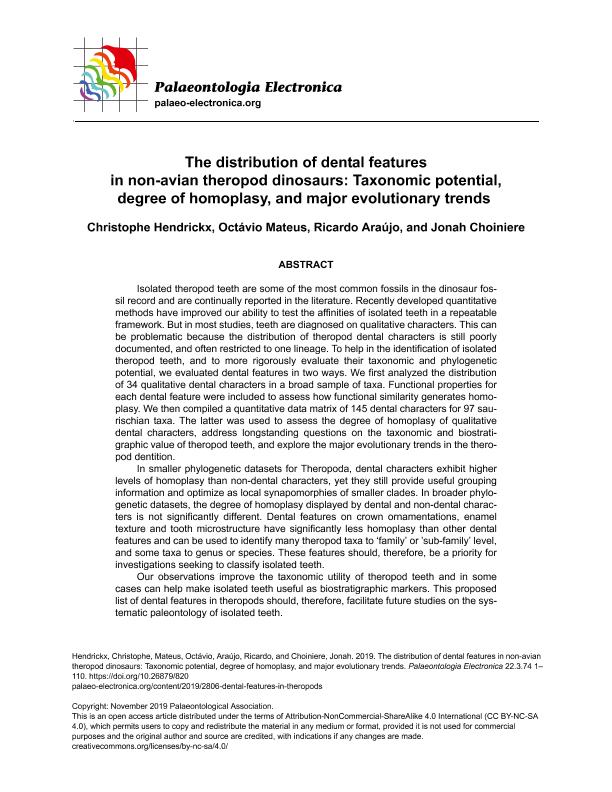Artículo
The distribution of dental features in non-avian theropod dinosaurs: Taxonomic potential, degree of homoplasy, and major evolutionary trends
Fecha de publicación:
11/2019
Editorial:
Coquina Press
Revista:
Palaeontologia Electronica
ISSN:
1532-3056
Idioma:
Inglés
Tipo de recurso:
Artículo publicado
Clasificación temática:
Resumen
Isolated theropod teeth are some of the most common fossils in the dinosaur fossil record and are continually reported in the literature. Recently developed quantitative methods have improved our ability to test the affinities of isolated teeth in a repeatable framework. But in most studies, teeth are diagnosed on qualitative characters. This can be problematic because the distribution of theropod dental characters is still poorly documented, and often restricted to one lineage. To help in the identification of isolated theropod teeth, and to more rigorously evaluate their taxonomic and phylogenetic potential, we evaluated dental features in two ways. We first analyzed the distribution of 34 qualitative dental characters in a broad sample of taxa. Functional properties for each dental feature were included to assess how functional similarity generates homoplasy. We then compiled a quantitative data matrix of 145 dental characters for 97 saurischian taxa. The latter was used to assess the degree of homoplasy of qualitative dental characters, address longstanding questions on the taxonomic and biostratigraphic value of theropod teeth, and explore the major evolutionary trends in the theropod dentition. In smaller phylogenetic datasets for Theropoda, dental characters exhibit higher levels of homoplasy than non-dental characters, yet they still provide useful grouping information and optimize as local synapomorphies of smaller clades. In broader phylogenetic datasets, the degree of homoplasy displayed by dental and non-dental characters is not significantly different. Dental features on crown ornamentations, enamel texture and tooth microstructure have significantly less homoplasy than other dental features and can be used to identify many theropod taxa to ‘family’ or ’sub-family’ level, and some taxa to genus or species. These features should, therefore, be a priority for investigations seeking to classify isolated teeth. Our observations improve the taxonomic utility of theropod teeth and in some cases can help make isolated teeth useful as biostratigraphic markers. This proposed list of dental features in theropods should, therefore, facilitate future studies on the systematic paleontology of isolated teeth.
Palabras clave:
EVOLUTION
,
FUNCTION
,
TEETH
Archivos asociados
Licencia
Identificadores
Colecciones
Articulos(UEL)
Articulos de UNIDAD EJECUTORA LILLO
Articulos de UNIDAD EJECUTORA LILLO
Citación
Hendrickx, Christophe; Mateus, Octávio; Araujo, Ricardo; Choiniere, Jonah N.; The distribution of dental features in non-avian theropod dinosaurs: Taxonomic potential, degree of homoplasy, and major evolutionary trends; Coquina Press; Palaeontologia Electronica; 22; 3; 11-2019; 1-10
Compartir
Altmétricas




